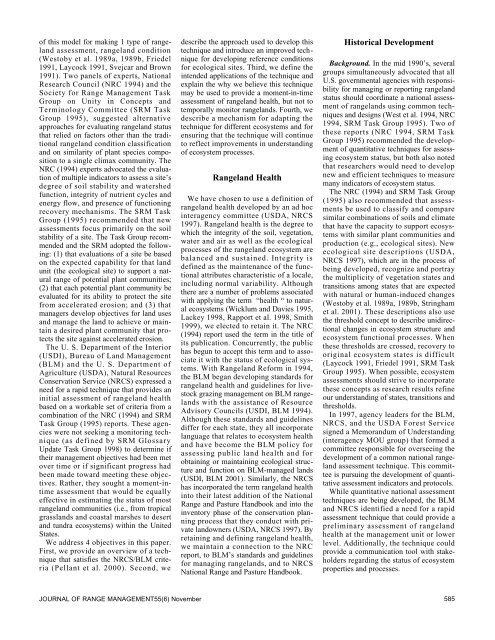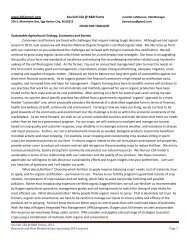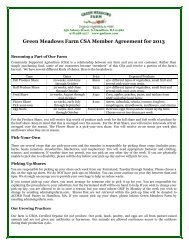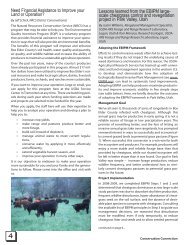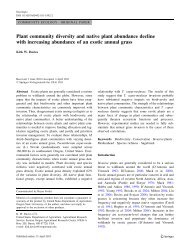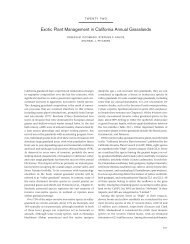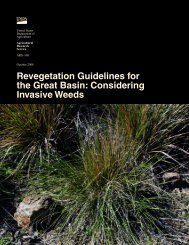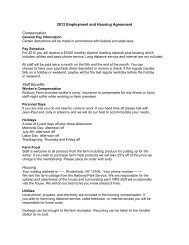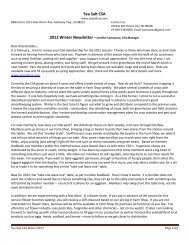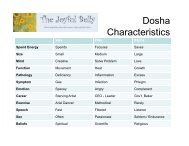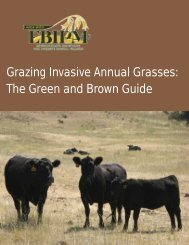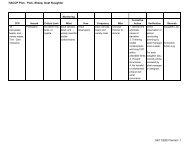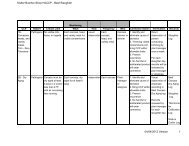Rangeland health attributes and indicators for qualitative assessment
Rangeland health attributes and indicators for qualitative assessment
Rangeland health attributes and indicators for qualitative assessment
You also want an ePaper? Increase the reach of your titles
YUMPU automatically turns print PDFs into web optimized ePapers that Google loves.
of this model <strong>for</strong> making 1 type of rangel<strong>and</strong><br />
<strong>assessment</strong>, rangel<strong>and</strong> condition<br />
(Westoby et al. 1989a, 1989b, Friedel<br />
1991, Laycock 1991, Svejcar <strong>and</strong> Brown<br />
1991). Two panels of experts, National<br />
Research Council (NRC 1994) <strong>and</strong> the<br />
Society <strong>for</strong> Range Management Task<br />
Group on Unity in Concepts <strong>and</strong><br />
Terminology Committee (SRM Task<br />
Group 1995), suggested alternative<br />
approaches <strong>for</strong> evaluating rangel<strong>and</strong> status<br />
that relied on factors other than the traditional<br />
rangel<strong>and</strong> condition classification<br />
<strong>and</strong> on similarity of plant species composition<br />
to a single climax community. The<br />
NRC (1994) experts advocated the evaluation<br />
of multiple <strong>indicators</strong> to assess a site’s<br />
degree of soil stability <strong>and</strong> watershed<br />
function, integrity of nutrient cycles <strong>and</strong><br />
energy flow, <strong>and</strong> presence of functioning<br />
recovery mechanisms. The SRM Task<br />
Group (1995) recommended that new<br />
<strong>assessment</strong>s focus primarily on the soil<br />
stability of a site. The Task Group recommended<br />
<strong>and</strong> the SRM adopted the following:<br />
(1) that evaluations of a site be based<br />
on the expected capability <strong>for</strong> that l<strong>and</strong><br />
unit (the ecological site) to support a natural<br />
range of potential plant communities;<br />
(2) that each potential plant community be<br />
evaluated <strong>for</strong> its ability to protect the site<br />
from accelerated erosion; <strong>and</strong> (3) that<br />
managers develop objectives <strong>for</strong> l<strong>and</strong> uses<br />
<strong>and</strong> manage the l<strong>and</strong> to achieve or maintain<br />
a desired plant community that protects<br />
the site against accelerated erosion.<br />
The U. S. Department of the Interior<br />
(USDI), Bureau of L<strong>and</strong> Management<br />
(BLM) <strong>and</strong> the U. S. Department of<br />
Agriculture (USDA), Natural Resources<br />
Conservation Service (NRCS) expressed a<br />
need <strong>for</strong> a rapid technique that provides an<br />
initial <strong>assessment</strong> of rangel<strong>and</strong> <strong>health</strong><br />
based on a workable set of criteria from a<br />
combination of the NRC (1994) <strong>and</strong> SRM<br />
Task Group (1995) reports. These agencies<br />
were not seeking a monitoring technique<br />
(as defined by SRM Glossary<br />
Update Task Group 1998) to determine if<br />
their management objectives had been met<br />
over time or if significant progress had<br />
been made toward meeting these objectives.<br />
Rather, they sought a moment-intime<br />
<strong>assessment</strong> that would be equally<br />
effective in estimating the status of most<br />
rangel<strong>and</strong> communities (i.e., from tropical<br />
grassl<strong>and</strong>s <strong>and</strong> coastal marshes to desert<br />
<strong>and</strong> tundra ecosystems) within the United<br />
States.<br />
We address 4 objectives in this paper.<br />
First, we provide an overview of a technique<br />
that satisfies the NRCS/BLM criteria<br />
(Pellant et al. 2000). Second, we<br />
describe the approach used to develop this<br />
technique <strong>and</strong> introduce an improved technique<br />
<strong>for</strong> developing reference conditions<br />
<strong>for</strong> ecological sites. Third, we define the<br />
intended applications of the technique <strong>and</strong><br />
explain the why we believe this technique<br />
may be used to provide a moment-in-time<br />
<strong>assessment</strong> of rangel<strong>and</strong> <strong>health</strong>, but not to<br />
temporally monitor rangel<strong>and</strong>s. Fourth, we<br />
describe a mechanism <strong>for</strong> adapting the<br />
technique <strong>for</strong> different ecosystems <strong>and</strong> <strong>for</strong><br />
ensuring that the technique will continue<br />
to reflect improvements in underst<strong>and</strong>ing<br />
of ecosystem processes.<br />
<strong>Rangel<strong>and</strong></strong> Health<br />
We have chosen to use a definition of<br />
rangel<strong>and</strong> <strong>health</strong> developed by an ad hoc<br />
interagency committee (USDA, NRCS<br />
1997). <strong>Rangel<strong>and</strong></strong> <strong>health</strong> is the degree to<br />
which the integrity of the soil, vegetation,<br />
water <strong>and</strong> air as well as the ecological<br />
processes of the rangel<strong>and</strong> ecosystem are<br />
balanced <strong>and</strong> sustained. Integrity is<br />
defined as the maintenance of the functional<br />
<strong>attributes</strong> characteristic of a locale,<br />
including normal variability. Although<br />
there are a number of problems associated<br />
with applying the term “<strong>health</strong> “ to natural<br />
ecosystems (Wicklum <strong>and</strong> Davies 1995,<br />
Lackey 1998, Rapport et al. 1998, Smith<br />
1999), we elected to retain it. The NRC<br />
(1994) report used the term in the title of<br />
its publication. Concurrently, the public<br />
has begun to accept this term <strong>and</strong> to associate<br />
it with the status of ecological systems.<br />
With <strong>Rangel<strong>and</strong></strong> Re<strong>for</strong>m in 1994,<br />
the BLM began developing st<strong>and</strong>ards <strong>for</strong><br />
rangel<strong>and</strong> <strong>health</strong> <strong>and</strong> guidelines <strong>for</strong> livestock<br />
grazing management on BLM rangel<strong>and</strong>s<br />
with the assistance of Resource<br />
Advisory Councils (USDI, BLM 1994).<br />
Although these st<strong>and</strong>ards <strong>and</strong> guidelines<br />
differ <strong>for</strong> each state, they all incorporate<br />
language that relates to ecosystem <strong>health</strong><br />
<strong>and</strong> have become the BLM policy <strong>for</strong><br />
assessing public l<strong>and</strong> <strong>health</strong> <strong>and</strong> <strong>for</strong><br />
obtaining or maintaining ecological structure<br />
<strong>and</strong> function on BLM-managed l<strong>and</strong>s<br />
(USDI, BLM 2001). Similarly, the NRCS<br />
has incorporated the term rangel<strong>and</strong> <strong>health</strong><br />
into their latest addition of the National<br />
Range <strong>and</strong> Pasture H<strong>and</strong>book <strong>and</strong> into the<br />
inventory phase of the conservation planning<br />
process that they conduct with private<br />
l<strong>and</strong>owners (USDA, NRCS 1997). By<br />
retaining <strong>and</strong> defining rangel<strong>and</strong> <strong>health</strong>,<br />
we maintain a connection to the NRC<br />
report, to BLM’s st<strong>and</strong>ards <strong>and</strong> guidelines<br />
<strong>for</strong> managing rangel<strong>and</strong>s, <strong>and</strong> to NRCS<br />
National Range <strong>and</strong> Pasture H<strong>and</strong>book.<br />
Historical Development<br />
Background. In the mid 1990’s, several<br />
groups simultaneously advocated that all<br />
U.S. governmental agencies with responsibility<br />
<strong>for</strong> managing or reporting rangel<strong>and</strong><br />
status should coordinate a national <strong>assessment</strong><br />
of rangel<strong>and</strong>s using common techniques<br />
<strong>and</strong> designs (West et al. 1994, NRC<br />
1994, SRM Task Group 1995). Two of<br />
these reports (NRC 1994, SRM Task<br />
Group 1995) recommended the development<br />
of quantitative techniques <strong>for</strong> assessing<br />
ecosystem status, but both also noted<br />
that researchers would need to develop<br />
new <strong>and</strong> efficient techniques to measure<br />
many <strong>indicators</strong> of ecosystem status.<br />
The NRC (1994) <strong>and</strong> SRM Task Group<br />
(1995) also recommended that <strong>assessment</strong>s<br />
be used to classify <strong>and</strong> compare<br />
similar combinations of soils <strong>and</strong> climate<br />
that have the capacity to support ecosystems<br />
with similar plant communities <strong>and</strong><br />
production (e.g., ecological sites). New<br />
ecological site descriptions (USDA,<br />
NRCS 1997), which are in the process of<br />
being developed, recognize <strong>and</strong> portray<br />
the multiplicity of vegetation states <strong>and</strong><br />
transitions among states that are expected<br />
with natural or human-induced changes<br />
(Westoby et al. 1989a, 1989b, Stringham<br />
et al. 2001). These descriptions also use<br />
the threshold concept to describe unidirectional<br />
changes in ecosystem structure <strong>and</strong><br />
ecosystem functional processes. When<br />
these thresholds are crossed, recovery to<br />
original ecosystem states is difficult<br />
(Laycock 1991, Friedel 1991, SRM Task<br />
Group 1995). When possible, ecosystem<br />
<strong>assessment</strong>s should strive to incorporate<br />
these concepts as research results refine<br />
our underst<strong>and</strong>ing of states, transitions <strong>and</strong><br />
thresholds.<br />
In 1997, agency leaders <strong>for</strong> the BLM,<br />
NRCS, <strong>and</strong> the USDA Forest Service<br />
signed a Memor<strong>and</strong>um of Underst<strong>and</strong>ing<br />
(interagency MOU group) that <strong>for</strong>med a<br />
committee responsible <strong>for</strong> overseeing the<br />
development of a common national rangel<strong>and</strong><br />
<strong>assessment</strong> technique. This committee<br />
is pursuing the development of quantitative<br />
<strong>assessment</strong> <strong>indicators</strong> <strong>and</strong> protocols.<br />
While quantitative national <strong>assessment</strong><br />
techniques are being developed, the BLM<br />
<strong>and</strong> NRCS identified a need <strong>for</strong> a rapid<br />
<strong>assessment</strong> technique that could provide a<br />
preliminary <strong>assessment</strong> of rangel<strong>and</strong><br />
<strong>health</strong> at the management unit or lower<br />
level. Additionally, the technique could<br />
provide a communication tool with stakeholders<br />
regarding the status of ecosystem<br />
properties <strong>and</strong> processes.<br />
JOURNAL OF RANGE MANAGEMENT55(6) November<br />
585


